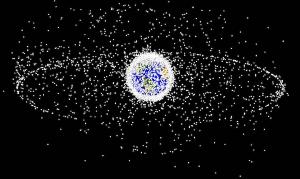Blog
How To Build A
Garbage Truck In Space
1 July 2018
 NASA
NASAWhat goes up must come down, unless it is in orbit around Earth.
When the Soviet Union launched Sputnik 1 into orbit in 1957, it not only ushered in an age of human space exploration, it also marked the beginning of littering in space. With every launch of a new spacecraft, more debris is put into orbit. Everything from panels and bolts to paint chips and tools. While some of this orbital junk soon enters Earth’s atmosphere and burns up, much of it remains in orbit. Orbital speeds are nearly 30,000 km/hr, so even small objects can pose a serious threat. Even large objects can collide. In 2009 the Iridium 33 and Kosmos-2251 satellites collided at high speed, destroying both spacecraft and creating more dangerous debris.
Currently we track more than 300,000 objects orbiting Earth. About 5,000 of these are satellites, while the rest is debris. Of course that’s only the stuff large enough for us to track, at least a centimeter across. While that sounds like a lot, space is pretty big, so generally the risk of an impact is pretty low. But it’s not zero, and each impact makes more fragments. One concern is that we could reach a tipping point where more collisions create more debris, leading to a cascade of collisions making Earth orbit too dangerous. We’re not there yet, but if we want to travel to Mars and beyond, we need to start cleaning up all this trash.
Recently the RemoveDEBRIS mission was launched to study four ways we might clean up some of our orbital trash. It contains two cubesats. One will try to image debris to see how it might best be captured. Another will launch a small balloon simulating debris, then try to capture the balloon with a net. A third experiment will fire a harpoon at a target to see if it could capture larger debris objects. Finally, RemoveDEBRIS will deploy a drag sail to slow itself down. This should cause the satellite to enter Earth’s atmosphere and burn up.
This is only an early experiment. It will take a lot more research to solve all the problems with debris capture. But it’s a problem we have to solve. Otherwise our orbital trash will prevent us from ever reaching the stars.